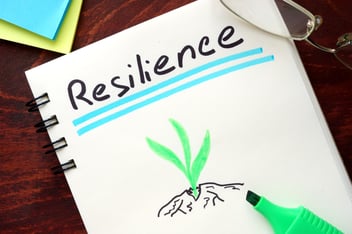
Imagine a senior leadership team telling their entire department to “go take a risk.”
Written by Janice Francisco
I recently completed a four-month engagement with a client who told their department exactly that.
Last summer, we got the call. Our client was looking for a way to engage staff in an experience that would help them make concrete and internalize the requirement to “be more innovative.”
Like many organizations, our client has established a corporate strategic direction that asks leaders and their teams to make innovation a standard practice in their day-to-day work. In this client’s world, the strategic ask is for departments to:
Foster a culture of innovation and engage in business innovation.
What does that mean?
What Is a Culture of Innovation?
Well, like many organizations, the specifics aren’t clear. Senior leaders haven’t defined what they mean by “innovation” and the delivery and manifestation of this strategy is left to the interpretation of individual departments and their business units. This isn’t necessarily a bad thing because innovation isn’t “one size fits all.”
However, to get the most out of a strategic direction for innovation, someone in the organization (typically departmental or divisional leaders) needs to ask the “who, what, where, when, why and how we will innovate?” questions. And that’s exactly how this client handled the lack of specific direction on innovation from the top of their organization.
The client shared this about their work environment:
- There was a headcount freeze and a concern that demands of work were growing. Faced with limits on their resources, the environment was ripe for assessing, not how to do more with less, but rather where could we do less work? The leadership team was interested in having staff assess what they could stop doing that wasn’t contributing real value in the organization, and opportunities to streamline existing processes, thereby saving employees time and effort. They certainly didn’t want staff to feel they had to take on more work in an already time-pressured work environment.
- There was great diversity in the work between business units in the department. However, everyone played a role in supporting senior executives in the organization in some way – either through strategic planning, support to the board of directors, in meeting the demands of their day-to-day work, or in supporting governance functions.
- Employees generally perceived the requirement to “be more innovative” as a “side of the desk” activity that would suck time out of their day and keep them from moving through their already lengthy to-do lists.
- At a corporate level, the organization had made a statement recognizing that risks were a natural and needed part of the innovation strategy. In fact, the corporation established guidelines around taking risks and outlined the parameters of its risk appetite so that the necessary change in the organization and benefits of innovation could be realized. The challenge was, no staff members in this department were lining up to tell their senior executives about risks and changes they wanted to take, fearing failure and other perceived repercussions.
- The nature of the work of the department meant the senior leadership team wanted to avoid having people away from the job for more than half a day to do a learning event – anymore and participation by many staff would be at risk due to work demands.
So, what did we do?
How Do You Teach Risk-taking?
We immediately floated the idea of offering our Taking a Risk on Innovation course.
The course met the time criteria – it could be delivered in half a day, it scales easily to any size audience on an intact team, and it works to help individuals explore their practices and preferences for risk-taking.
And, to build a bridge to engaging in risks necessary to producing innovation, course participants would brainstorm what they would need in their workplace to feel safe to take innovation risks.
The client loved what we had to offer.
From there we asked a simple question: which is more important to you?
Do you want to give people a cognitive understanding of the importance of taking risks to produce innovation?
OR,
Do you wish to produce changes in behaviour around risk taking and innovation?
The client’s answer: they needed to create long-term changes in behaviour around risk taking and innovation.
Knowing that time and availability of leaders and staff in the department were limited and pressured, we designed a learning process that mirrored a typical innovation journey and aligned the learning to corporate and departmental strategies for innovation and engaging in risk. It included pre- and post-training activities that would help the senior leadership team lead the learning in the organization that would create the necessary changes in behaviour.
Our objective was to make the call “to be more innovative” relevant, personal, practical and desirable for everyone on the team. To meet this objective, the post-training innovation process that Ginny and I designed:
- Engaged individuals on each team in creating a safe risk manifesto for their team so everyone on the team—leader included—was accountable to norms for behaviour that would make it safe to engage in intelligent risk-taking when innovating
- Had each team identify and implement an innovation experiment they were willing to take a risk on doing; the experiment had to be initiated but didn’t have to be completed before a planned culminating event
- Provided decision criteria and guidelines around the kinds of “innovation” that was wanted: in a nutshell, find things that we could stop, start or continue to do—only better—without adding resources, without asking for more budget, and that were within their control and responsibility to change
- Had each team reflect on their experiment, and prepare a story to share with the entire department about the successes and failures surrounding their experiment and what they learned about taking risks when innovating. Whether the experiment was still in progress or completed at the timing of this learning step, all teams were to reflect on and share their experience thus far in a culminating event.
We framed the engagement to help the leaders and staff in the organization explore and discover answers to this essential question:
How do we experience innovation risks and what’s the opportunity for taking more?
Innovating Your Behaviour
Change in behaviour comes first. This is achieved by developing an awareness of the behaviours you engage in that create your current state, relative to the new behaviours you need to move you to the desired state. So, an organization that is perceived as risk averse needs to understand how they enable risk aversion relative to how they need to behave to create an appetite for risk-taking. Once they’ve figured that out, individuals in that organization need to take action—step-by-step—to unlearn the behaviours that aren’t contributing to the new state. Then, they need to learn new behaviours that will create and sustain the new state.
In essence, individuals need to innovate how they behave.
Here’s the investment our client’s organization made to learn how to appreciate and enjoy an appetite for risk:
- Four planning and coaching sessions for the senior leadership team, two delivered before training, one during the experiment, and one after the culminating learning event
- A half day of training for the entire department
- Up to 90 minutes for each team to create their safe risk manifesto and identify an experiment that had to be initiated but did not have to be completed during the timeframe allocated for this learning. Teams were given the latitude to set their own timeline for completion; the only requirement was to get started.
- On-the-job time for each team, led by their senior leader, to conduct their innovation experiment
- Up to 90 minutes for each team to capture ideas and prepare a story, in a creative way, to share with the department about their key learnings
- A half-day culminating event where each team—leader included—shared their story to the entire department
It was a simple solution with great impact.
The Unexpected Side Benefit
At the culminating event, the entire team assembled to share what they learned about taking risks, having success and dealing with failure. And, an amazing thing happened.
Not only did the learning event meet the objectives we set out achieve, it provided an unexpected side benefit: team building.
Why?
It lifts everyone up.
Everyone had to contribute to building and giving the key learnings presentation. As a result, departmental members got to hear from and witness the creativity, contribution, humility and growth of each team. More importantly, the department heard from people they don’t normally hear from who really got to shine, and each team learned from the experience of everyone else.
The constraints we gave to developing and delivering the final presentation were to tell a story from the heart, without benefit of a standard corporate PowerPoint presentation. Open for possibility were skits, stories, mind maps, visual boards, haiku poetry – stuff that felt risky for delivering key learnings. And everyone masterfully rose to the challenge.
 Here’s a sampling of what we heard during the presentations:
Here’s a sampling of what we heard during the presentations:
“We started this learning skeptical and questioning why we needed to do it. Then we realized it’s about creating value.”
“We realized our weekly two-hour leadership team meeting could be done better and differently, so we experimented with options. In the end, we streamlined and shortened the meeting to focus on sharing what is relevant to moving forward. We realized we do—and have to—trust each other; the meeting isn’t about proving how busy we are, it’s about focusing on what’s relevant to the job. We estimate we’ll save twelve person days per year on meetings… and that’s a lot of bottom line dollars in executive salary.”
“We realized that when capacity and resources are a crunch, asking, ‘When is less more?’ gets us out of our knee-jerk responses and opens up other possibilities.” (This team examined the work they were doing to produce a series of reports used in the organization for decision-making. Turns out what they were doing was inconsistent with practices in other areas of their corporation. By reaching out to learn from others about their practices, this team was able to recognize and recommend improvements that would be real time savers for their team.)
“We were really excited about our experiment, and when we realized the change we wanted to make was possible, we moved quickly to get it implemented. But we got stopped in our tracks when it became evident that you can’t make a change you think is great without involving others; it’s not only about what you need, you need to take their needs into account too.”
“We learned that by hearing all our voices and welcoming everyone’s ideas and challenging our assumptions about what we could or couldn’t do, we were actually building our team. We saw the benefits of working this way together in other areas of our work.”
One team did a skit to illustrate the challenges around an accepted business and approval process. In time-critical situations, it was taking up to five business days to move things through a governance process. The skit so beautifully demonstrated the hoops staff were jumping through to make things happen, that you could visibly see the discomfort in the audience. As they wrapped up, the entire leadership team looked painfully at each other with one leader saying, “Point taken, we definitely need to fix that.” The team recommended streamlined workflow, a move to digital signatures, and involving IT, Audit and Security groups in the discussion about how to make the needed changes.
As we wrapped up the culminating event, feedback from leaders and their teams created the realization that the journey surrounding this learning effort produced a deeper respect of the challenges facing each team, appreciation for the diversity of ways in which innovation can be experienced in day-to-day work, and served to debunk the perception in the organization that there was no time to innovate. As one person shared, “Innovation is possible in your day-to-day work if you keep open to the possibility there is a better way to do something”.
One team created a poster board to show what they had come to realize is a typical innovation journey. In making their presentation, the team said:
“You start all excited, hoping all will be good! You move down the road and you come across traffic lights. Eventually you get stopped and run into obstacles along the road. But you have to keep trying and keep learning. And soon you realize the road to innovation takes many paths – there’s not only one way, and as you see different ways emerge you have to yield to them, and figure out how to merge them into your plans. There are speed bumps, detours, and unexpected surprises – some are good, others are truly unpleasant. But if you keep at it, you eventually get to the end of the road and when you look back, you find it was worth it.”
What the Leadership Team Learned
In a final meeting I had with the leadership team, they said they were really pleased with the results and in awe of what had happened. “It put some lift under everyone to get thinking about what we could stop doing, start to do, and do differently,” they reported.
The leadership team admitted that at times they too found themselves skeptical and wondering would it really come together. But, they were willing to trust and keep moving forward under my guidance. “This is what it means to lead innovation,” I explained.
Reflecting on the original challenge of risk and failure, the leadership team realized that soon after their teams started doing the experiment, all talk about the risks and failing lifted. The teams weren’t concerned about failing; they were focusing on doing a good job and finding a result that worked. The process changed their perspective, which moved from, "It's risky, I might fail," to, "How do I make this successful?"
As for results, not only were they able to attune themselves and their staff to what it really means to be innovative, they were happy to see that staff realized they did have the ability to innovate in areas where something was bugging them and they wanted to get it fixed, that it didn’t take a huge effort or a big project – it just took a process and a willingness to get started.
What’s Next?
You might be wondering: what’s next for this team?
Our client’s leadership team realized that they could now lead the organization through this process again, and again, and again. What we provided was an agile and repeatable process for them to put their work under a microscope and examine where they could make changes to support themselves and deliver greater value to the organization. As true innovators, they’re going back to the team in an upcoming departmental meeting to share their own key learnings about innovation in their department, and they want to use this process as a way to feed the strategic planning process.
What I liked about this engagement was that the leadership team was willing to take a risk on leading a change in the organization and a learning event that might produce failure. And by taking that risk, the payback was cost savings to the organization, team building, engaged employees, and deep respect of the personal and organizational value created from a concerted effort to engage in innovation.
Ready to take a risk, create an organizational culture of innovation, or produce changes in behaviour around risk taking and innovation?
I'll listen to what you're going through and work with you to find a solution.


